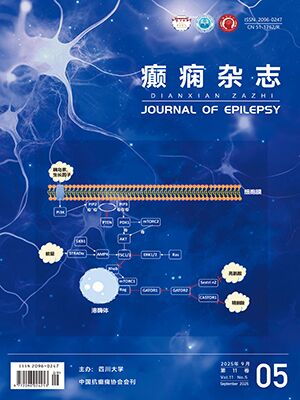| 1. |
Dagar A, Falcone T. Psychiatric comorbidities in pediatric epilepsy. Current psychiatry reports, 2020, 22(12): 77.
|
| 2. |
Li F, Cui Y, Li Y, et al. Prevalence of mental disorders in school children and adolescents in China: diagnostic data from detailed clinical assessments of 17, 524 individuals. J Child Psychol Psychiatry, 2022, 63(1): 34-46.
|
| 3. |
李桃利, 王艺. 癫痫儿童神经精神共患病的研究进展. 复旦学报(医学版), 2018, 45(4): 578-584.
|
| 4. |
Reddy DS. The neuroendocrine basis of sex differences in epilepsy. Pharmacol Biochem Behav, 2017, 152: 97-104.
|
| 5. |
Singer HS. Tics and tourette syndrome. Continuum (Minneap Minn), 2019, 25(4): 936-958.
|
| 6. |
Weng WC, Huang HL, Wong LC, et al. Increased risks of tic disorders in children with epilepsy: a nation-wide population-based case-control study in Taiwan. Res Dev Disabil, 2016, 51-52: 173-180.
|
| 7. |
Slaght SJ, Paz T, Chavez M, et al. On the activity of the corticostriatal networks during spike-and-wave discharges in a genetic model of absence epilepsy. J Neurosci, 2004, 24(30): 6816-6825.
|
| 8. |
Avchalumov Y, Kirschstein T, Köhling R. Altered physiology and pharmacology in the corticostriatal system in a model of temporal lobe epilepsy. Epilepsia, 2011, 52(1): 151-157.
|
| 9. |
Vinti V, Dell'isola GB, Tascini G, et al. Temporal lobe epilepsy and psychiatric comorbidity. Front Neurol, 2021, 12: 775781.
|
| 10. |
Bouilleret V, Semah F, Chassoux F, et al. Basal ganglia involvement in temporal lobe epilepsy: a functional and morphologic study. Neurology, 2008, 70(3): 177-184.
|
| 11. |
Ciumas C, Wahlin TB, Espino C, et al. The dopamine system in idiopathic generalized epilepsies: identification of syndrome-related changes. Neuroimage, 2010, 51(2): 606-615.
|
| 12. |
Odano I, Varrone A, Savic I, et al. Quantitative PET analyses of regional [11C]PE2I binding to the dopamine transporter-application to juvenile myoclonic epilepsy. Neuroimage, 2012, 59(4): 3582-3593.
|
| 13. |
Rheims S, Auvin S. Attention deficit/hyperactivity disorder and epilepsy. Curr Opin Neurol, 2021, 34(2): 219-225.
|
| 14. |
Szejko N, Jakubczyk A, Janik P. Prevalence and clinical correlates of self-harm behaviors in gilles de la Tourette Syndrome. Front Psychiatry, 2019, 10: 638.
|
| 15. |
Peters J, Vijiaratnam N, Angus-Leppan H. Tics induced by antiepileptic drugs: a pragmatic review. J Neurol, 2021, 268(1): 321-336.
|
| 16. |
Tellez-Zenteno JF, Patten SB, Jetté N, et al. Psychiatric comorbidity in epilepsy: a population-based analysis. Epilepsia, 2007, 48(12): 2336-2344.
|
| 17. |
Liu ZS, Cui YH, Sun D, et al. Current status, diagnosis, and treatment recommendation for tic disorders in China. Front Psychiatry, 2020, 11: 774.
|
| 18. |
Kious BM, Jimenez-Shahed J, Shprecher DR. Treatment-refractory Tourette syndrome. Prog Neuropsychopharmacol Biol Psychiatry, 2016, 70: 227-236.
|




